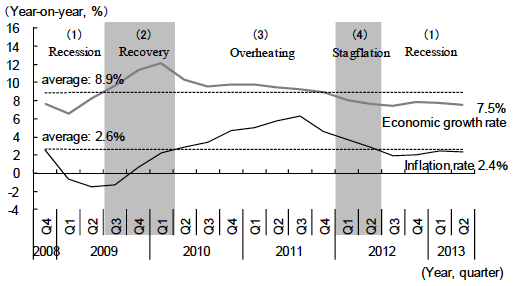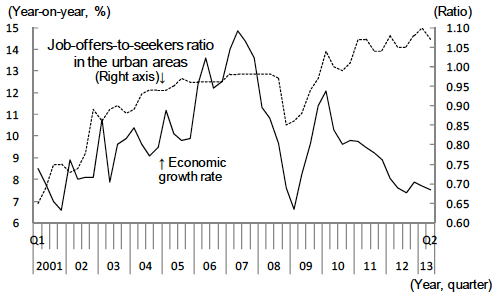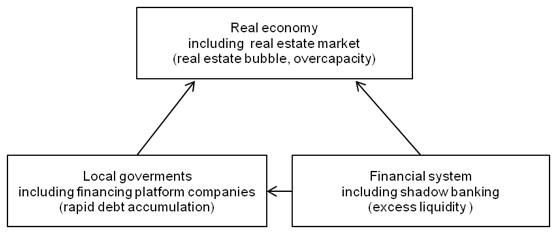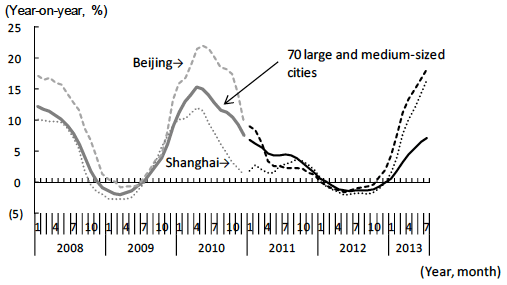Introduction
Although China achieved high growth at an average annual rate of 9.8% from 1978 to 2012, a period when the country shifted its policies to reform and opening up of the country, its growth rate has been falling sharply in recent years, and its high-growth period may have come to an end. In the second quarter of 2013, the economic growth rate fell to 7.5% while the inflation rate was only 2.4%. Based on the average values (growth rate of 8.9% and inflation rate of 2.6%) for the period since the collapse of Lehman Brothers (from the fourth quarter of 2008 to the second quarter of 2013), from the third quarter of 2012, the Chinese economy entered into a recession, with low growth and low inflation (Figure 1).
–– Changes in the economic growth vs. the inflation rate

In the previous recession, when China suffered the effects of the global financial crisis, the government introduced a large-scale economic stimulus package of as much as four trillion yuan (equivalent to 12.7% of GDP in 2008) along with aggressive monetary easing. This stimulus resulted in the Chinese economy's sharp recovery in the second half of 2009. Following the slower growth this time, however, the government has been reluctant to respond promptly to the increasing calls for a massive economic stimulus. In particular, Li Keqiang, who became premier in the spring of 2013, made clear of his position of giving higher priority to medium- and long-term structural reforms over short-term economic stimulus.
Behind this lies concern about the risks that could destabilize the macroeconomy, such as an expansion of the housing bubble, a negative legacy of the previous economic measures, as well as the significant drop in the potential growth rate. Amid the falling potential growth rate, if the government tries to achieve growth exceeding this potential growth rate through expansionary fiscal and monetary policies, these risks are more likely to come to the surface. This is also a lesson China can learn from Japan's experience during its bubble period in the late 1980s.
Falling potential growth rate
In China, the working-age population (from age 15 to 59) declined in 2012 for the first time, and the aging of the population is accelerating, as the country's one-child policy, launched in 1980, has come back to haunt it. In addition, the surplus labor that was observed in the rural areas in the past has been almost entirely eliminated due to the country's rapid industrialization and urbanization, and the Lewisian turning point—or the achievement of full employment in the development process— appears to have been reached. Given the decline in the working-age population and the arrival of the Lewisian turning point, a fall in the potential growth rate is inevitable in China.
First, the fact that the working-age population is beginning to decline means that the demographic dividend will turn into a demographic onus; that is, a population burden. In the past, the working-age population continued to increase, and the savings rate was also high in a society centered on young people. The growing working-age population resulted in a greater supply of labor, while the high savings rate led to an increase in capital input, as domestic savings were the major source of investment funds. On the other hand, a declining working-age population and a progressively aging society will hold down the growth rate due to a smaller labor supply and a lower savings rate.
The arrival of the Lewisian turning point will also constrain growth. The supply of labor, which was thought to be unlimited in the past, has been underpinning economic growth in China through the following channels. First, the absorption of the surplus labor in the agricultural sector by the industrial and service sectors directly contributed to the expansion of the GDP. Second, the shift of labor from the agricultural sector, with low productivity, to the industrial and the service sectors, with higher productivity, increased the productivity of the overall economy. In addition, keeping wages low due to the labor surplus worked in favor of the high-income group with high capital income in terms of income distribution, which in turn resulted in higher savings and investment. However, the achievement of full employment means the loss of these advantages, and therefore the potential growth rate will have to fall.
The shift in the working-age population from an upward to a downward trend and the shift from underemployment to full employment usually occur at different times. Japan, for example, is believed to have achieved full employment in the early 1960s (Ryoshin Minami, Nihon Keizai no Tenkan Ten: Roudou no Kajo kara Fusoku e [The Turning Point of the Japanese Economy: From a labor surplus to a labor shortage] , Sobunsha, 1970), but its working-age population did not begin decreasing until around 1995 (World Population Prospects: The 2012 Revision, United Nations). In contrast, these two turning points appear to have arrived at the same time in China, thus the extent of the labor shortage and the subsequent impact on its economy are greater than in other countries.
Against the backdrop of these changes in the labor market, the job-offers-to-seekers ratio in urban areas increased to 1.07 in the second quarter of 2013 from 1.10 in the first quarter, despite the significantly lower growth rate in recent years (Figure 2). This is in contrast to the sharp fall in the job-offers-to-seekers ratio along with a lower growth rate in early 2009. Given a situation in which the number of job offers from companies is greater than the number of job seekers in the labor force, China's current potential growth rate appears to have already fallen below its actual growth rate of 7.5%.
–Arrival of the Lewisian turning point and drop in the potential growth rate–

Looming threat of an economic crisis
Along with the falling potential growth rate, the destabilization of the macroeconomy is beginning to be of concern, given the increase in loans provided by the shadow banking system, the expansion of the housing bubble, and an increase in the debt of the financing platforms established by local governments (Figure 3).

First, shadow banking in China refers to credit intermediation involving entities and activities outside of the regular banking system, with the functions of liquidity and credit transformation, which could potentially cause systemic risks or regulatory arbitrage. The core of the shadow banking system consists of wealth management products sold by banks and trust products sold by trust companies. The combined size is estimated to have reached 16.9 trillion yuan as of the end of March 2013 (the China Banking Regulatory Commission and the China Trustee Association), which is equivalent to 36% of GDP.
The shadow banking system is a way to avoid supervisory and administrative regulations through financial innovation. The Chinese authorities have set interest-rate regulations and relatively high reserve requirement ratios (currently 20.0% for large banks), and are seeking to rein in bank lending through the loan-to-deposit ratio (75%) and window guidance, etc. As market competition has intensified, banks have come to use shadow banking as a financing method in lieu of traditional channels in order to avoid regulations. However, unless shadow banking is placed under the effective supervision of authorities, risks could increase. In particular, sharply increasing loans through shadow banking are flowing into the real estate market directly or through financing platforms and contributing to soaring housing prices.
Second, following the monetary easing after the collapse of Lehman Brothers, the real estate market has experienced a steep rise in sales prices in major cities. To keep the housing bubble from expanding further, the Chinese government has announced and implemented a series of policies since 2010. Major steps to curb demand include restrictions on loans, limits on purchases, and a hike in real estate-related taxes, while the primary measure to increase supply is to accelerate the construction of public housing for low-income groups. Following these measures, the year-on-year rate of increase in sales prices of newly constructed residential buildings in 70 large and medium-sized cities remained negative for 10 consecutive months since March 2012. However, since January 2013, it has turned positive once again following the resumption of monetary easing. In July 2013, the prices of newly constructed residential buildings in 70 large and medium-sized cities rose 7.1% year on year, and the rate of increase was particularly high in large cities such as Beijing and Shanghai, where it rose 18.3% and 16.5%, respectively (Figure 4). There is also concern that if the housing bubble expands further, the banking sector and the macroeconomy will be hard hit when it bursts.

Price Indices of Newly Constructed Commercial Residential Buildings from January 2011. 70 large and medium-sized cities is the simple average.
Furthermore, in addition to the shadow banking system and the expansion of the housing bubble, the debt held by local governments and financing platforms in particular is also considered to be a problematic factor that could destabilize the macroeconomy. The financing platforms mentioned here refer to economic entities with an independent corporate status that were established by local governments and their agencies by investing their fiscal funds, land, and stock holdings to assume the function of financing the investment projects of these governments. Under the current fiscal system, local governments have continually suffered from a shortage of revenue but are prohibited from issuing bonds on their own. Under these restrictions, local governments have established numerous financing platforms to raise funds for infrastructure investments. In particular, to finance the economic stimulus package of four trillion yuan implemented after the Lehman Brothers collapse in September 2008, the Chinese government started allowing fund-raising by financing platforms. Combined with the implementation of monetary easing, the number of financing platforms across the country increased sharply, along with their debt. In addition to traditional bank loans, shadow banking has become a major source of funds for financing platforms.
According to the National Audit Office, the balance of debt of local governments across the country amounted to 10.72 trillion yuan (26.7% of GDP) at the end of 2010, of which approximately 60% was created after 2008. Looking at the debt by borrowing entity, financing platforms made up 4.97 trillion yuan (46.4% of the debt balance), larger than the 2.50 trillion yuan (23.3%) of local governments and agencies (No. 35 of 2011 "Audit Findings on China's Local Government Debts," June 27, 2011). These statistics have not been updated by the authorities since then, but former Minister of Finance Xiang Huaicheng's statement at the Boao Forum for Asia in April 2013 suggests that the local government debt might have already exceeded 20 trillion yuan by the end of 2012. As the economy is sluggish, there is increasing concern about the risk of default, mainly regarding the debt of financing platforms.
Likonomics and China's new economic strategy
To break an impasse in which the risk of an economic crisis is increasing while the potential growth rate is falling significantly, Premier Li Keqiang is promoting an economic policy (so-called "Likonomics") consisting of three pillars: the "maintenance of stable growth," "structural adjustments," and the "promotion of reforms." As Premier Li points out, "Stabilizing growth will create sufficient leeway and conditions for structural adjustments, while structural adjustments will provide sustainability for economic development, and both will complement each other. China will be able to inject new momentum into stable growth and structural adjustments by eliminating impediments in the institution and the system through reforms" (statement made at a roundtable discussion held in Guangxi on July 9, 2013, regarding economic conditions in certain provinces and autonomous regions).
1) Maintenance of stable growth
With respect to the maintenance of stable growth, Premier Li points out that the main purpose of macro control is to keep the economic growth rate above a certain level and the inflation rate below a certain level by avoiding large fluctuations in the economy. Although specific numbers were not given, the growth rate of 7.5% and the inflation rate of 3.5% announced at the National People's Congress held in March 2013 can be used as a reference. China also has to prevent an economic crisis from occurring by making its use of funds more efficient through financial and fiscal reforms. Above all, there is an urgent need to curb the expansion of loans by the shadow banking system, the debt of local governments, and the rise in housing prices.
2) Structural adjustments
Regarding structural adjustments, changing the economic development pattern will be the top priority. More specifically, it will be necessary to shift from investment to consumption in terms of demand, from manufacturing to services in terms of industry, and from the expansion of inputs such as labor and capital to a rise in productivity by improving the innovation capability of companies and industrial upgrading, etc. in terms of the mode of production.
To facilitate structural adjustments, financial support programs were determined at the Standing Committee Meeting of the State Council, held on June 19, 2013. The following four items were considered to be the most important:
- Guide loans toward supporting the real economy. For this purpose, increase financial support to refurbish and refine advanced manufacturing industries, strategic emerging industries, labor-intensive manufacturing and service industries, and traditional industries.
- Support an adjustment of excess capacity, provide loans for mergers and acquisitions (M&A) to integrate companies with excess capacity, and strictly prohibit the expansion of new loans to construction projects that violate regulations in industries with excess capacity.
- Increase loans to agricultural and small enterprises that have difficulty obtaining loans from formal financial institutions and have to depend on informal financing.
- Encourage private capital to participate in the restructuring of financial institutions, and to establish banks, financial leasing companies, and consumer finance companies.
3) Promotion of reforms
With regard to the promotion of reforms, a review of the division of roles between the government and the market will be a focal issue. To boost the vitality of the market and private-sector companies, a fair market environment must be created by deregulating and breaking up the monopoly of state-owned enterprises in many areas. At the same time, the role of the government must be strengthened in the areas of environmental protection and public services, such as social security, medical services, and education, which are directly linked to people's everyday lives.
As part of this initiative, focused efforts to enhance the reform of the economic system were determined at the Standing Committee Meeting of the State Council, held on May 6, 2013. Among these, the following five items should attract attention:
- Review, eliminate, and transfer the authority to issue permits and licenses regarding investment projects and production and management activities.
- Develop measures to control the risk arising from the increasing debt of local governments by formulating an overall plan to enhance the reform of the budget system.
- Gradually implement market-oriented reforms of interest rates and exchange rates and propose an execution plan to liberalize capital transactions.
- Open up the ownership and management right of railways to private capital by creating a reform plan for the railway investment and loan system, and encourage private capital to invest in existing main railways.
- Promote a new type of people-oriented urbanization by reforming the household registration system and develop related public services and a social security system. (Note) Protect the legitimate interests of farmers.
Under the auspices of Premier Li, an economic reform plan, presumably the definitive edition of Likonomics that systematizes these policies, is being compiled. Its content will be revealed at the third plenary session of the 18th Central Committee of the Communist Party of China, to be held in November 2013. We should look to this reform plan for important clues regarding the direction of the Chinese economy.
The original text in Japanese was posted on September 11, 2013.


